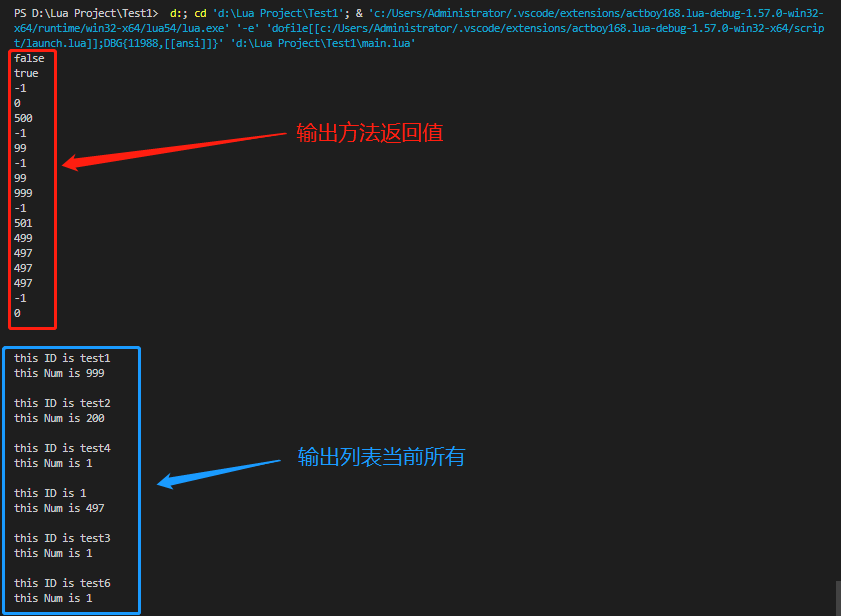作者:殷小苗_535 | 来源:互联网 | 2023-08-26 15:12
引言:最近刚稍微深入了解一下Lua,正好最近需要用到Lua中对表的操作,于是借助现有的了解实现了对一个简单的二维表进行添加、修改、计算、删除及判断存在的操作 表的创建及相关方法:
引言:
最近刚稍微深入了解一下Lua,正好最近需要用到Lua中对表的操作,于是借助现有的了解实现了对一个简单的二维表进行添加、修改、计算、删除及判断存在的操作
表的创建及相关方法:
1. 创建表及自定义一个迭代器:
--1.当作这是一个操作类/表;该表为一个二维列表,每一个元素代表一个表
--2.每一个元素(表)中包含 id 和 num
operatiOnList= {}
--1.列表元素迭代器,仅返回列表中每一个元素,改列表索引必须为连续的数字
function listIterator(list)
local index = 0;
local listLen = #list
return function ()
index = index + 1
if index <= listLen then
return list[index]
end
end
end
2. 向表中添加数据
--1.向操作类/表中添加数据,oId代表标识ID,onum代表值当前值
--2.当 oId 已在列表中存在时,不进行添加操作
--2.当 oId 为nil时,默认为 “1”,当 onum 为nil时,默认为 1
--3.oId 类型为string,oNum 类型为number
--4.添加成功返回 true,失败则返回 false
function operationList:add(oId, oNum)
if not operationList:exist(oId) then
table.insert(self, {id = oId or "1", num = oNum or 1})
return true
end
return false
end
3. 修改表中数据
--1.修改operationList指定 ID 的值
--2.oId为指定ID,oNum为修改值,ifNum为指定ID的指定值,oCreate为是否新建值
--2.oId 类型为string,oNum 类型为number,ifNum类型为number,oCreate类型为boolean
--3.当该 ID 不存在时且参数 oCreate = true,则创建
--4.若当前 ID 存在, oNum 为 nil,ifNum 不存在,返回当前 ID 的 num 值
--5.若当前 ID 存在, oNum 不为 nil,ifNum 不存在,则为修改后的 num 值
--6.若当前 ID 存在, oNum 不为 nil,ifNum 存在,则为修改后的 num 值
--7.若当前 ID 存在, oNum 不为 nil,ifNum 不存在,返回当前 ID 的 num 值
--8.若当前 ID 不存在,且 oCreate = false 或 = nil,则返回数字 -1
--9.若当前 ID 不存在,且 ocreate = true,则创建对应 ID 和 num = 1 的新子列,再返回数字 0
function operationList:alter(oId, oNum, ifNum, oCreate)
if not ifNum then
for ol in listIterator(operationList) do
if ol.id == oId then --若与要修改的ID相同
if oNum then --若修改值不为nil
ol.num = oNum --修改值
end
return ol.num --返回当前值,若无修改值,则返回原来的值
end
end
else
for ol in listIterator(operationList) do
if ol.id == oId then --若与要修改的ID相同且 该ID的值 = 判定值
if ol.num == ifNum then
ol.num = oNum --修改值
end
return ol.num --返回当前值,若原来的值不等于ifNum的值,则返回原来的值
end
end
end
if not oCreate then --若列表不存在 oId,且 oCreate的值为false
return -1 --返回 -1
end
operationList:add(oId, 1) --若列表不存在 oId,且 oCreate的值为true
return 0 --返回 0
end
4. 计算表中值数据


--1.计算operationList指定 ID 的值
--2.oId为指定ID,computeNum为计算值,ifNum为指定ID的指定值,oCreate为是否新建值
--2.oId 类型为string,computeNum 类型为number,ifNum类型为number,oCreate类型为boolean
--3.当该 ID 不存在时且参数 oCreate = true,则创建
--4.若当前 ID 存在, computeNum 为 nil,ifNum 不存在,返回当前 ID 的 num + 1 值
--5.若当前 ID 存在, computeNum 不为 nil,ifNum 不存在,则为修改后的 num + computeNum 值
--6.若当前 ID 存在, computeNum 不为 nil,ifNum 存在,则为修改后的 num + computeNum 值
--7.若当前 ID 存在, computeNum 不为 nil,ifNum 不存在,则返回当前 ID 的 num 值
--8.若当前 ID 不存在,且 oCreate = false 或 = nil,则返回数字 -1
--9.若当前 ID 不存在,且 ocreate = true,则创建对应 ID 和 num = 1 的新子列,再返回数字 0
function operationList:compute(oId, computeNum, ifNum, oCreate)
if not ifNum then --如果相等判定值不存在
for ol in listIterator(operationList) do
if ol.id == oId then
if not computeNum then --如果计算值为空,那么原值默认 + 1
ol.num = ol.num + 1
else
ol.num = ol.num + computeNum --计算值不为空,那么原值 + 计算值
end
return ol.num
end
end
else
for ol in listIterator(operationList) do
if ol.id == oId then
if ol.num == ifNum and computeNum then
ol.num = ol.num + computeNum
end
return ol.num
end
end
end
if not oCreate then --若列表不存在 oId,且 oCreate的值为false
return -1 --返回 -1
end
operationList:add(oId, 1) --若列表不存在 oId,且 oCreate的值为true
return 0
end
View Code
5. 删除指定ID的数据
--1.从表移除指定 ID 的子列
--2.oId 类型为string
--3.移除成功返回 true,失败返回 false(只有当oId不存在时才会失败)
function operationList:remove(oId)
local removeIndex
for olI, olV in pairs(operationList) do
if olV.id == oId then --如果找到ID,则将对应索引传递给removeIndex
removeIndex = olI
break
end
end
if not removeIndex then
return false
end
table.remove(operationList, removeIndex)
return true
end
6. 判断指定ID是否存在表中
--1.判断指定 ID 在operationList中是否存在
--2.oId 类型为string
function operationList:exist(oId)
for ol in listIterator(operationList) do
if ol.id == oId then
return true
end
end
return false
end
对以上方法进行测试:
1. 测试代码:
--下面是向表operation中插入数据及输出结果
operationList:add("test1", 100)
operationList:add("test2", 200)
operationList:add("test3", 300)
operationList:add("test4")
operationList:add(nil, 500)
--下面是操作表
operationList:remove("test3") --移除数据
print(operationList:exist("11")) --判断 ID = 11 的子列是否存在,输出false
print(operationList:exist("1")) --判断 ID = 1 的子列是否存在,输出true
print(tostring(operationList:alter("test3"))) --通过修改值方法向列表添加新值,输出 -1
print(tostring(operationList:alter("test3", nil, nil, true))) --通过修改值方法向列表添加新值,输出 0
print(tostring(operationList:alter("1"))) --获取 ID = 1 的值,因为存在,输出当前 ID 的值
print(tostring(operationList:alter("11"))) --获取 ID = 11 的值,因为不存在,输出 -1
print(tostring(operationList:alter("test1", 99))) --修改 ID = test1 的值为 99,因为存在,输出修改后的值
print(tostring(operationList:alter("11", 99))) --修改 ID = 11 的值为 99,因为不存在,输出 -1
print(tostring(operationList:alter("test1", 999, 100))) --修改 ID = test1 且当前值 = 100 的值为 999,因为ID存在 但 值判断值不相同,输出当前值
print(tostring(operationList:alter("test1", 999, 99))) --修改 ID = test1 且当前值 = 99 的值为 999,因为ID存在 且 值判断值相同,输出修改后的值
print(tostring(operationList:alter("11", 666, 999))) --修改 ID = 11 且当前值 = 999 的值为 666,因为ID不存在,输出 -1
print(tostring(operationList:compute("1"))) --计算 ID = 1 的值,其他参数为空,获得原值 + 1
print(tostring(operationList:compute("1", -2))) --计算 ID = 1 的值,计算值 = -2,获得原值 - 2
print(tostring(operationList:compute("1", -2, 499))) --计算 ID = 1 的值,计算值 = -2,且当前值 = 499 获得原值 - 2
print(tostring(operationList:compute("1", nil, 497))) --计算 ID = 1 的值,计算值 = nil,且当前值 = 497 获得原值
print(tostring(operationList:compute("1", -2, 499))) --计算 ID = 1 的值,计算值 = -2,但当前值 ~= 499 获得原值
print(tostring(operationList:compute("test6", -2, 499))) --计算 ID = test6 的值,计算值 = -2,但当前值 ~= 499 且 oCreate = nil ,不创建新子列,获得返回值 -1
print(tostring(operationList:compute("test6", -2, 499, true))) --计算 ID = test6 的值,计算值 = -2,但当前值 ~= 499 且 oCreate = true 创建新子列,获得返回值 0
--输出列表
print("\n")
for thisoL in listIterator(operationList) do
print("this ID is "..thisoL.id.."\nthis Num is "..thisoL.num.."\n")
end
2. 测试结果图:

以上就是全部内容了